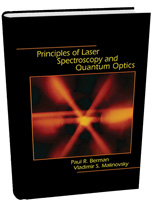
This high-quality, well-written book is a fine addition to the literature of modern optics. The title accurately describes the substantial contents, though the subject matter is actually narrower than might have at first been inferred. As the authors make clear in the introduction, it's all about atoms. Although many other developments are taking place in the study of molecular systems, cavities and nanoparticles, this volume focuses on atomic response. It is not meant as a comprehensive treatment, but if the authors had included any more material, this book would have become unwieldy. At over 500 pages, their subject coverage achieves a very respectable length.
This theoretical treatise is roughly half on optical spectroscopy and half on quantum optics and associated interactions. There is an extensive analysis of two-level atoms, including a standard density matrix formulation. The treatment of atomic motion leads into coverage of atom trapping and laser cooling, but there is no section on Bose-Einstein condensates. This omission is recognized in the preface, but it seems a little odd to exclude this particular topic. Still, the overall coverage is quite thorough.
The level of detail given by Berman and Malinovsky, both in the main text and appendices, is significantly greater than used to be found in textbooks. I found less of the familiar mantras “it can be shown” or “it follows that.” I believe the authors’ more detailed elaboration will significantly enhance the clarity for many readers, especially students. The general style is lucid and entirely fitting for a textbook. Each chapter includes a large number of problems and a useful bibliography. A solutions manual is also available. There are some errors, but they have been corrected in a recently updated support web page.
I concur with most of what the authors write, though I cannot agree with their statement: “any field in which the ... average number of photons in the field is less than or on the order of the number of atoms with which the field interacts must usually be treated using a quantized field approach”. Despite my own inclination towards quantum representations, this affirmation doesn't really bear scrutiny. In a book of this high calibre it would have been worth reflecting more carefully on the assertion. Still, this is a very minor carp. In all, this is a splendid book and I am confident that it will be widely received with considerable enthusiasm.
Review by David L. Andrews, professor of chemistry, University of East Anglia, United Kingdom.
The opinions expressed in the book review section are those of the reviewer and do not necessarily reflect those of OPN or OSA.
